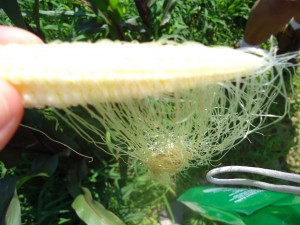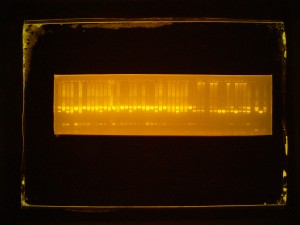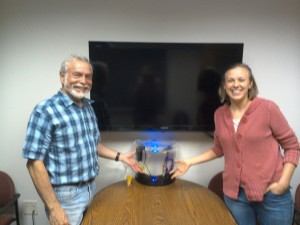Curriculum! Externship Experience!
Curriculum! Externship experience! How can I share the experience with my students? How can I relate the experience so that they are filled with the same curiosity that I am? I can’t. It is just not possible to take graduate level work and push it into my 8th grade lesson.
However, I can model the experience that I have had. The most rewarding part of my externship was just exploring and learning about all the different applications of genetically modified organisms (GMOs), the research being done in labs, and social science surrounding biotechnology.
I want my curriculum to give my students an opportunity to investigate and to understand using the information that they gather from readings, video clips, and group discussions. Then I want to give the students time to discuss new biotechnology topics with peers. I also want to provide a lab experience so the students can model part of the process used to create transgenic organisms. Finally, I want to provide a podcast to reinforce the basic knowledge needed to understand each of the learning objectives for the lesson. I think the combination of giving the students an opportunity to explore several applications of biotechnology and then reinforcing the baseline objectives will help them be confident learners.
This week I was excited to attend a great program at NCSU. A last minute administrative issue canned that plan. But it opened an even more awesome opportunity to attend the NCSU Crop Research Center workshop. The workshop turned out to be a great way to get ideas for my lesson. The workshop today made me realize that my Kenan lesson plan is a work in progress and I think it will evolve as I take advantage of workshops and seminars about GMOs. Below are some pictures of corn hybrids being researched at the center. They were created using a seed bank. This particular selection of seeds (known as a heritage selection) came from all the corn planted in a field in western Carolina about one hundred years ago. At the time, no selection was done by the farmer.
Where do you begin when you have an options buffet?
July 12, 2014
As I have been reflecting about what I will bring back to my class, I have thought about possible options from Dr. Gould’s genetics lab. Dr. Gould’s lab and their work on transgenic crops and insects directly connects to my units on evolution, biotechnology, and microbiology.
Maybe a better question to ask is: how can I plan a schizophrenic unit? Not really possible when I am hoping to also give my students a thoughtful lesson that builds on their current science understanding and provides a platform for their high school science. So I went back to the standards and wrote the SWBAT statements. I have started to reduce my buffet to a plate size proportion that will primarily focus on biotechnology and its impact on society.
The videos I put together with collaborating scientists will come in handy here. I will offer them as an enrichment piece for my students. Here is an example of one of the videos. This video can be used as a lesson about malaria. I was going to use this as a flipped classroom option for my students.
Dr. Kuzma and GES at NCSU
July 7-12, 2014
Based on your experiences, what are the greatest challenges for leveraging technology to empower learning in your classroom and school?
July 5, 2014
I think the biggest challenge for leveraging technology in our school is access to computers. We have one computer cart that is shared by five teachers. When I do use the computer cart with my students, I plan assignments/projects that can be completed during a class time. I am torn about having students use their phones or tablets during class since I feel it divides my class into the haves and the have nots. As a result, I use students’ personal technology devises sparingly.
The other challenges I have for leveraging technology to empower my students’ learning, is my students’ access to the internet. For students to collaborate using Google docs or presentations, they need to have internet access at home. One of the neighborhoods that is part of our school has a community center that opens a computer lab in the evenings for students to complete their homework. Although this is a wonderful program, I am concerned about my students walking home in the dark. As a result, I provide a variety of project choices that include both technology and non-technology options so that all my students can complete their assignments.
My students’ access to technology impacts the ease with which they can get answers. I find that my students that do not have the access to computers and internet access at home are also students that are struggling to complete their homework on time. I provide morning and after school support for these students. However, this is a poor substitute for having full access at home.
Great Week in Dr. Gould’s and Dr. Lorenzen’s Lab
Monday June 30 – July 3, 2014
|
Earlier this week, I visited Dr. Marcé Lorenzen’s lab and watched Clay Chu insert DNA into beetle embryos. Follow the video link on the right to see him explain how transgenic beetles are made. Clay also explains the importance of his research on wild type species for which we have very little genome knowledge. I learned an interesting fact about his work: only 2% of the embryos that have DNA inserted will develop into adult beetles. Clay’s research will take a great deal of time and patience to complete. |
Dr. Lorenzen’s Lab NCSU 2014 – DNA Insertion
|
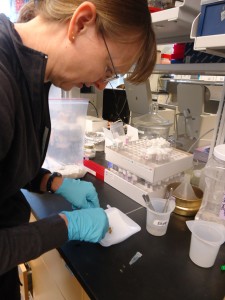
Later on in the afternoon, I returned to Dr. Gould’s Lab to help Emma with a DNA extraction. I enjoyed this work after reading related articles and listening to a visiting professor’s presentation. It allowed me time to think and reflect on what I was learning. Another fun find that a visiting researcher shared with us this week: Thanks to Jen Baltzegar, a graduate student in Dr Gould’s lab, I was able to extract DNA, amplify the DNA using PCR, and then run a gel on the samples to view the results. This was a two day process of separating the DNA and preparing samples for the PCR and gel electrophoresis. After taking a picture of the gel, Jen reviewed the image carefully marking specific areas of the gel as positive or negative for a particular region of DNA. This information was used to continue certain moth breeding lines that are currently being researched. The time and commitment necessary to maintain a breeding facility and document the DNA samples from the crosses being done was admirable. I simply could not appreciate the process before working in Dr. Gould’s lab.
|
|
I had a wonderful conversation with Dr. Gould and I was even able to catch him on Video. I asked him to talk about why he went into research and how students can get involved in research. The video clip link is posted below. Dr. Fred Gould Becoming a research Scientist YouTube link: http://youtu.be/5y8o6iirTrw |
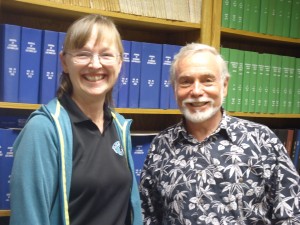 |
Highlight of my week at NCCAT
The week at NCCAT was wonderful. It was packed with information and I now have many things I want to use with my students. I cannot wait to try “Remind” (http://remind.com) to text my students and parents. This will be a great resources to use when we are going on field trips or when I just need to send out a project reminder.
Eric Rowles’ presentation was one of the highlights of the week. Eric provided several interesting examples of how I can use technology with students. I was especially intrigued by the “Miranda” activity to show students how images/posts are difficult to remove from the internet.
The rafting trip, which included the cultural and ecological tour, was another highlight of the week. It was a wonderful way to get to know the other Kenan Fellows. I felt so much more relaxed after the rafting trip and better able to collaborate with the other Kenan fellows. It reminded me how important it is to bridge my classrooms to the outdoors.
The whole week at NCCAT was fantastic. I arrived nervous and apprehensive and left feeling confident about what it means to be a Kenan Fellow. I feel like I have an incredible network of teachers that I can use for support as I work with my students and other teaching professionals.
What do you hope to gain from this Kenan Fellows Program experience?
I think that the Kenan Program experience will help me develop as a profession and a leader. Today’s workshops were excellent and have inspired me to try several new things such as TXTSignal, foursquare, and Ning to improve my communications with students and develop engaging lessons. I know that the other Kenan fellows will continue to be a valuable resource for me throughout my teaching career.
First Week in Dr. Fred Gould’s Lab at NCSU
| First Day Meeting June 16,2014
Dr. Fred Gould and Dr. Megan Fitz with their transgenic pets |
My first week at Dr. Gould’s lab: I have really enjoyed getting to know the people that work with him. Dr. Megan Fitz has been great and provided opportunities for me to get involved in DNA extraction of Heliothis veresens (moth) which is a pest to cotton plants, tobacco and other crops. The DNA extraction technique that they use is a two day process. After the DNA is separated from the moth tissues, it is run through a PCR machine that allows the small amounts of DNA to be amplified. The DNA is then run on an electrophoresis gel to further separate the DNA into bands. Below, you can see Alex setting up the gel to run electrophoresis.
 |
|
| Alex is an undergraduate at NC State. Her experience in Dr. Gould’s lab has prompted her to change her major and pursue further studies in genetics. |
During my first week, I gained a better understanding of the research done in Dr. Gould’s lab. Their work on insect pests such as moths has given us a better understanding of how insects evolve overtime as result of the use of Bacillus thuringiensis (Bt) crops. The incredible part of this research project is that it was only possible because of the foresight of Dr. Gould. Before the implementation of Bt crops in 1997, Dr Gould started collecting the targeted pests such as the Heliothis veresens moth. His collections have enabled research on how selective pressure causes changes in the genetic structures of insects.
I found most of the lab work and data collection relies on precision and attention to detail. But what makes the work interesting is the passion that these individuals have for their research. Dr. Megan Fitz is currently tracking the chikungunya disease as it moves into the US carried by its mosquito vector. She is trying to initiate collection of mosquitoes prior to the disease entering an area. She hopes find ways to combat the transmission of the disease by comparing the DNA of the infected mosquitoes with the uninfected mosquitoes. While Dr. Marce Lorenzen is fascinated by the tick that is causing heartwater disease and trying to think of ways to stop the disease from infecting cattle in the US. Both researchers are driven by their passion to control disease and it is their future focus, imagination, and research skills that help us better understand the insects and the diseases they carry.
I think one thing that is evident from working in the lab this week is that these scientists are all very passionate about their research and the impact it has on our health, crops, and pest management.
Watch Dr. Megan Fitz’s Mosquitoes Population
I love this video of Dr. Marce Lorenzen. I am especially interested by how difficult school was for her in middle school. Many students that I had this year could relate this and would be cheered by her example.
First Meeting For “The Genetics of Pest Control”
I met with Dr Fred Gould and Dr. Jennifer Kuzma on Friday, June 13. I am fortunate to work with such great people. I feel excited and a little overwhelmed. I am eager to see Dr Gould’s lab on Monday.

Dr Jennifer Kuzma suggested that I start reading, Frankenstein’s Cat, Cuddling up to Biotech’s Brave New Beasts by Emily Anthes. It is a fascinating read. I was surprised with how far we have come in using animals to develop pharmaceuticals.
Dr Fred Gould also mentioned that I might be interested in metagenomics since I have been monitoring water quality with my 8th grade class for many years. Metagenomics is a survey of genes found in the environment without having to culture the organisms found in the environment. I would focus on microorganisms in a body of water. From the survey of the genomes you can determine the quality of water. I need to read more on this topic to understand how I could use this with my students.

